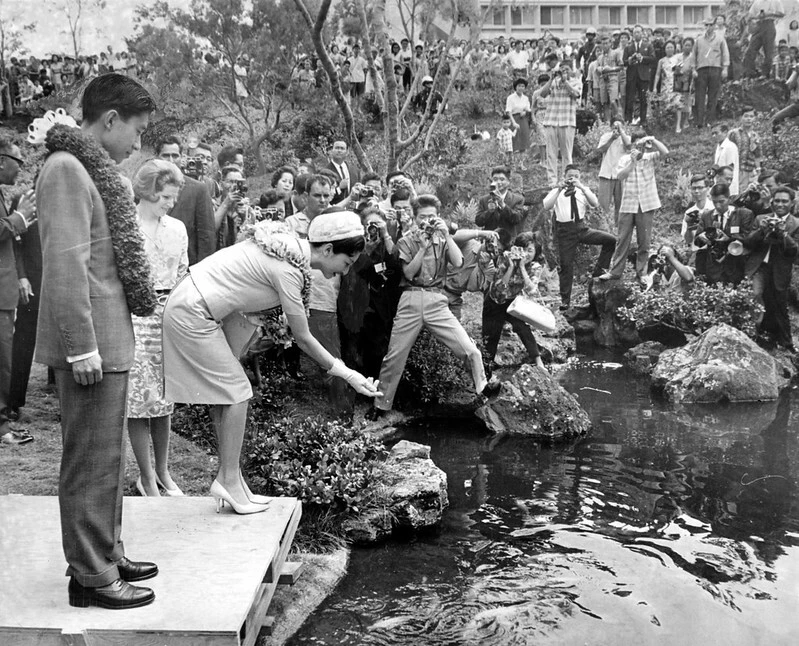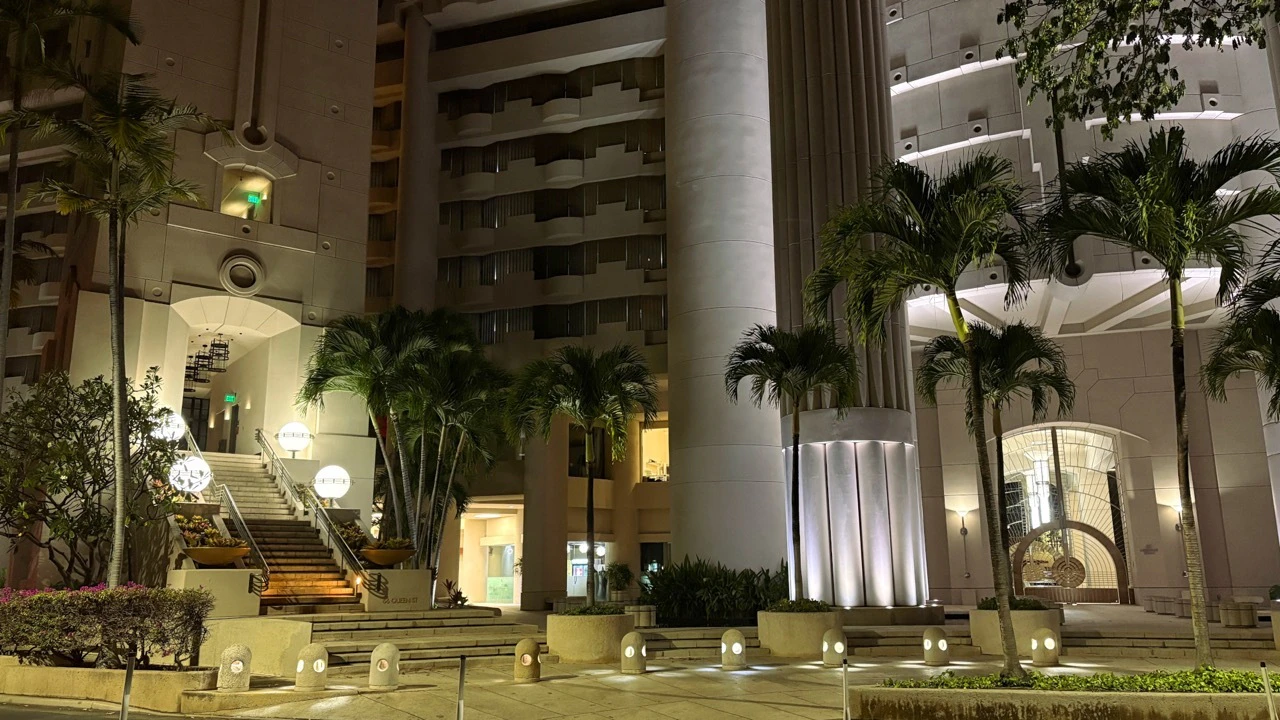For nearly two years, I lived in the dormitories of the East-West Center.
Designed by I.M. Pei, the rooms were time capsules of a different Hawai‘i, one I always sensed passed away decades ago.
Where the past is a foreign country, the East-West Center was a foreign place. The dividing line between the University of Hawai‘i and the East-West Center can also feel like a line separating the institution from the entire state of Hawai‘i.
If you’re from Hawai‘i, the physical grounds of East-West Center will feel foreign. Students from countries as disparate as Pakistan, Bhutan, South Korea, England, and Fiji — smattered from U.S. citizens from the continent — talk story with one another in shared dining areas.
Meanwhile, you’ll honestly struggle to find more than a handful of local kids in Hale Mānoa, the twelve-story dormitory where I lived.
Across the grounds is a Japanese garden blessed by the Japanese Prince (and future Emperor) Akihito. There is a Thai Pavilion gifted by the late Thai King Bhumibol Adulyadej and Queen Sirikit of Thailand. Two lions statues in front of the Imin Conference Center are gifted from the Taiwanese Government, known more officially from their inscriptions as the “Republic of China.”

Once a production of U.S. foreign policy at the height of the Cold War, recent federal pressures are forcing the East-West Center to engage more critically with present-day Hawai‘i. This newfound engagement, as evidenced by recent state legislation, should re-orient the East-West Center to become an explicitly Hawai‘i-focused institution for international engagement.
A bastion for Cold War foreign policy
The East-West Center is not part of the University of Hawai‘i. Although it commands a domineering presence on the Diamond Head side of the East-West Road (one of the main thoroughfares of the Mānoa campus), it is a very different institution.
When it was founded through the Center for Cultural and Technical Interchange Between East and West Act of 1960, national leaders like then-Senate Majority Leader Lyndon B. Johnson perceived the center as an opportunity for U.S. students, scholars, and rising leaders to gain the skills required to engage with peoples from across Asia and the Pacific.
By dint of geographic location and demographic character, Hawai‘i was the lucky recipient of this new, federally funded center. As the sixties matured, the East-West Center became a critical staging ground for framing relations with Asia in the context of expanding U.S. military operations in Vietnam, Cambodia and Laos.
“Symbolically, you stand as a bridge — a bridge between the two mainlands on either side of this wide ocean that surrounds all of these islands,” Johnson remarked at the East-West Center on October 18, 1966. “You remind us that our people and the people of Asia have much to give to each other as well as much to learn from each other.”
Hawai‘i continued to recognize the value of the East-West Center as a point of pride in their international stature. In 1975, the Hawai‘i State Legislature moved to formally designate the East-West Center as an educational nonprofit public corporation.
The law specified that the institution “shall not be considered a department, agency, or public instrumentality of the state, and shall not be subject to the laws of the state applying to departments, agencies and public instrumentalities of the state.”
In the aftermath of the Vietnam War, it was declared that the corporation “shall not be used to conduct non-education foreign policy goals of the United States or any other governments.” This may have been a jab at the center’s controversial role as a site for espionage and foreign intelligence surveillance throughout the sixties and early seventies.
The East-West Center was the perfect litmus for the grandiose, internationalist ambitions Hawai‘i harbored in the ’60s. With institutions like the East-West Center, there were expectations that Hawai‘i would become the “Geneva of the Pacific,” a true gathering place for the world’s people.
Half a century later, the nature of the relationship is evolving. In order to survive, the East-West Center cannot remain fully separate from the state of Hawai‘i.
A foreign institution
In an era before the advent of the internet and teleconferencing via platforms like Zoom, the importance of a physical meeting point between the continental U.S., Pacific countries, Australia and Asia could not be underscored.
While it stands as a central, geographic staging ground between the East and the West, the exact purpose of the center is now more uncertain than ever.
Federal officials, as was the case during the Obama Administration, are showing little interest in the East-West Center’s future. President Donald Trump Administration’s actions toward the institution have been much more severe.
According to the East-West Center’s Interim Communications Director Derek Ferrar, the last federal fiscal year (from October 2023 to September 2024) saw the East-West Center’s funding sources total approximately $42 million. The U.S. Congress appropriated $22 million and private funders donated $13.6 million, with public grants bringing-in $6.6 million. Between the funding appropriated by the U.S. Congress and other contracting and grant sources, the Trump Administration is blocking $28.6 million in federal aid.
Meanwhile, nearly four-in-five workers have been asked to voluntarily separate from the center. Since January, approximately one-quarter of the East-West Center’s staff of 160 personnel have departed.
These are among the many problems confronting Celeste Connors, who was chosen to serve as the next President of the East-West Center on July 1. In the official release announcing her selection, Randy Moore, the former chair of the University of Hawai‘i’s Board of Regents, highlighted her local, state and national ties as a critical strength.
“Celeste has developed strong contacts with leaders of Pacific Island nations,” he said, “Together with her prior experience in the U.S. Department of State and the White House, she is plugged into a network that will enable the center to productively serve Hawaiʻi, the nation and the world.”
In spite of these cuts, the responsibilities of the East-West Center are still serious. It still recruits students and academic researchers from across the Asia-Pacific Region to conduct timely research on topics like economic trends and climate change, operates programs (and stations its Vice President) in Washington, D.C., and hosts key initiatives like the Pacific Islands Development Program (a diplomatic forum for countries and territories across the Pacific Region).
Between the federal government’s hostility and their prevailing responsibilities, it may be reasonable to expect for funding – and institutional support to come from the state of Hawai‘i – instead of functioning primarily as an agent for American interests in Asia-Pacific region, it may more appropriately evolve to be an international center for Hawai‘i’s interests.
A more Hawai‘i-centric East-West Center
As federal funding withers, the East-West Center must now show itself as a critical partner in fostering relations between Hawai‘i and international partners and institutions across the Asia-Pacific region.
To do so, the East-West Center must explicitly pivot away from its federal origins. Following the 2025 legislative session, Gov. Josh Green signed Senate Bill 1578 into law as Act 158 on June 3. As part of the measure, the state is appropriating eight million dollars over the next two fiscal years to assist the East-West Center.
Act 158 found “that the center would benefit from regular, predictable state resources to support the development of programs and initiatives that align with the state's strategic goals in international relations, education and economic development.”
The state’s hefty goals align the East-West Center’s mission with the state’s Office of International Development, a minor office administratively attached to the state Department of Business, Economic Development, and Tourism. As part of this gambit, the state is also re-naming the semi-dormant Sister-State Commission as the Hawaiʻi Sister-State and International Partnerships Commission.
The new law is not intended to threaten the center’s independence, as “the allocation of state support shall neither impinge on the autonomy” of the East-West Center nor “imply state control over its programs or policies.”
It is a grandiose gambit, one that harkens back to the past. Whether the gambit is foolish is not yet known. It is a tight line to walk.
Hawai‘i may never become a bridge between the East and the West, but the East-West Center must navigate this new world to survive.
For the latest news of Hawai‘i, sign up here for our free Daily Edition newsletter.





